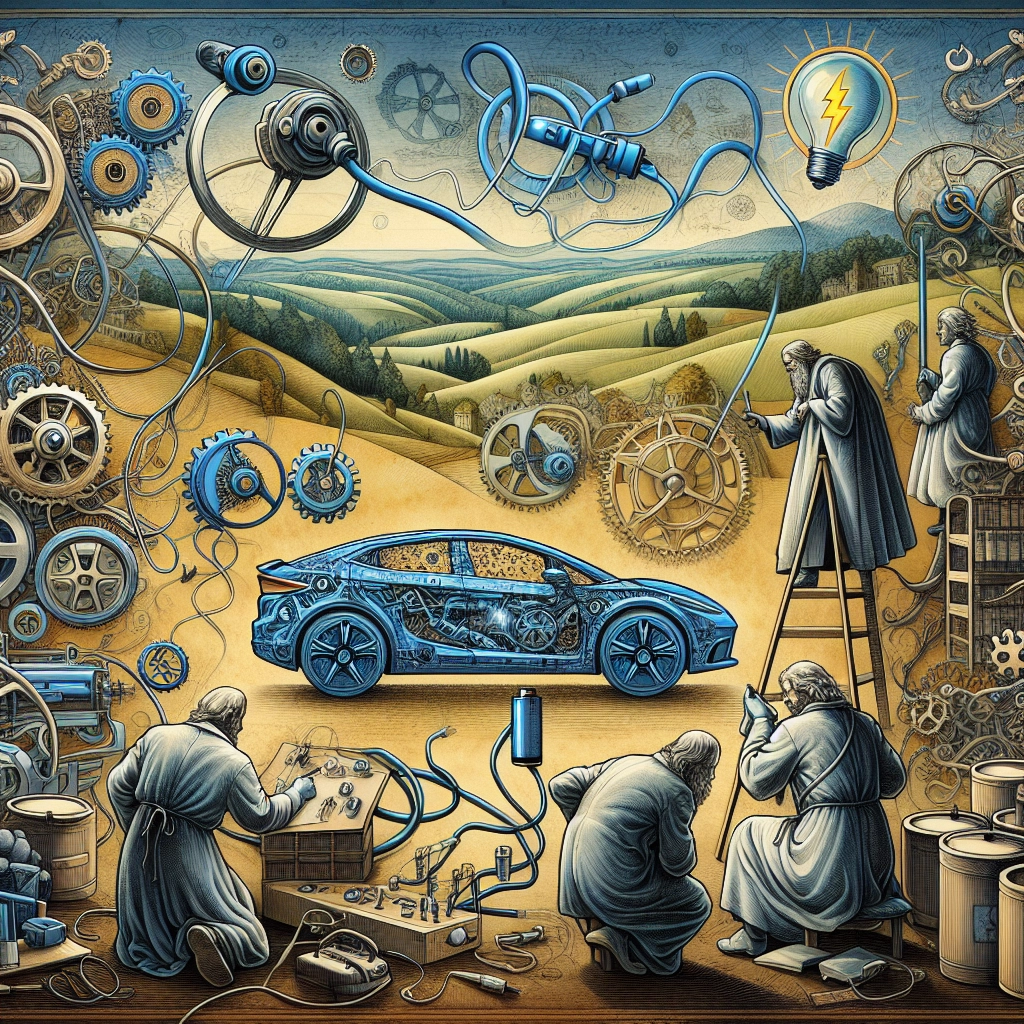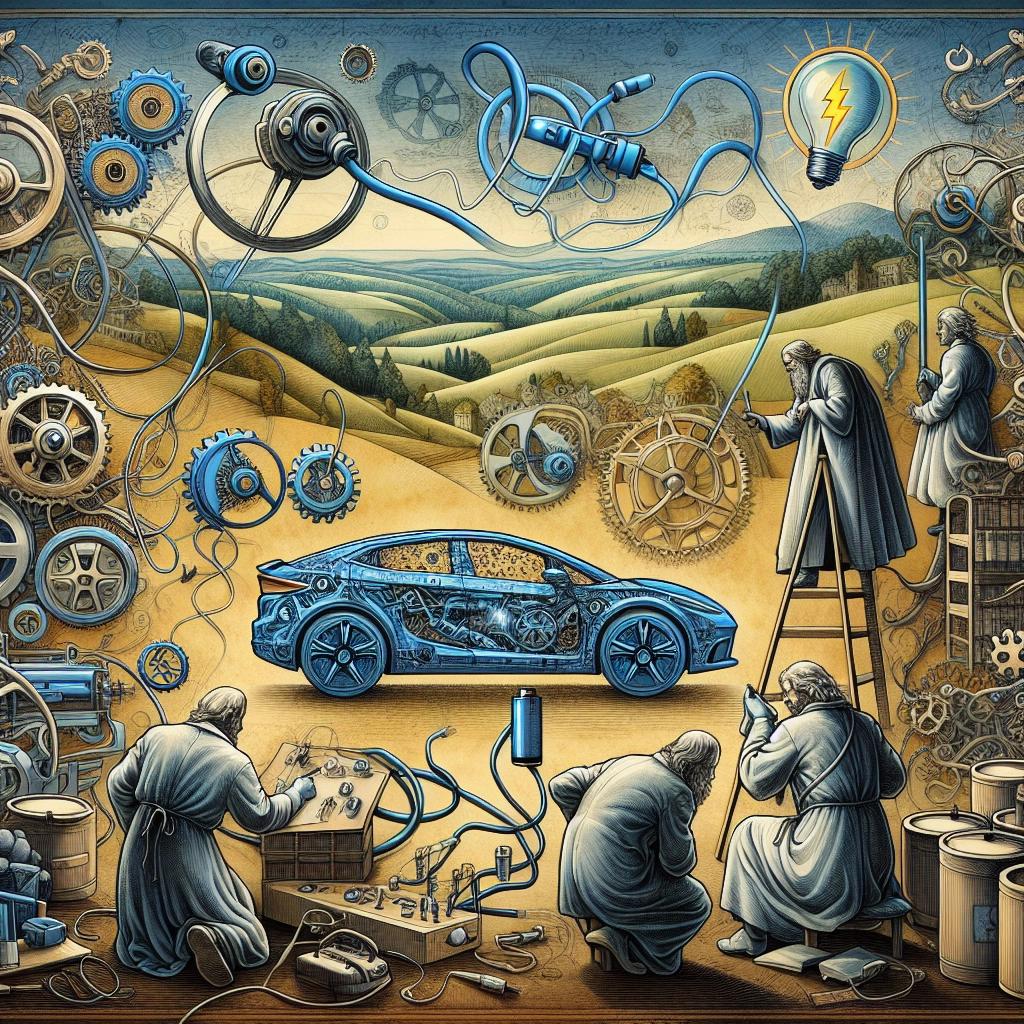The Electric Revolution: Exploring the Science Behind Electric Cars
 Quantum Cyber Solutions
Quantum Cyber Solutions

Published on
Saturday, August 19, 2023
The Electric Revolution: Exploring the Science Behind Electric Cars
=======================================================================
Authors

Name
Eric deQuevedo 😄
Twitter
🔌 The Rise of the Electric Machine: A Greener Future 🔌
In recent years, electric cars have emerged as a game-changer in the automotive industry, promising a more sustainable and environmentally friendly future for transportation. With their sleek designs, instant torque, and zero tailpipe emissions, electric vehicles (EVs) have captured the imagination of drivers worldwide. But have you ever wondered about the science and technology that powers these modern marvels? In this blog post, we'll explore the inner workings of electric cars and uncover the innovations that are driving us towards a greener future.
🔋 The Heart of the Electric Beast: Lithium-Ion Batteries 🔋
At the core of every electric car lies a sophisticated battery system, most commonly based on lithium-ion technology. These batteries are designed to store and deliver the electrical energy needed to power the vehicle's electric motor(s) and other systems.
Lithium-ion batteries offer several key advantages over other battery types:
High Energy Density: Lithium-ion batteries can store more energy per unit of weight and volume compared to other rechargeable batteries, enabling electric cars to have longer driving ranges.
Low Self-Discharge: When not in use, lithium-ion batteries lose their charge at a much slower rate than other battery types, ensuring that electric cars can maintain their charge for extended periods.
Fast Charging: Lithium-ion batteries can be charged relatively quickly, with some electric cars capable of reaching 80% charge in as little as 30 minutes using fast-charging stations.
Long Lifespan: With proper care and management, lithium-ion batteries can last for many years and thousands of charging cycles, making them a durable and reliable choice for electric vehicles.
The battery pack in an electric car is typically composed of numerous individual lithium-ion cells, arranged in modules and controlled by a sophisticated battery management system (BMS). The BMS monitors the health and performance of each cell, ensuring optimal charging, discharging, and thermal management to maximize battery life and safety.
⚡ The Power of the Motor: Converting Electricity to Motion ⚡
While the battery serves as the energy storage device, it's the electric motor that actually propels the vehicle. Electric motors convert electrical energy into mechanical energy, using the principles of electromagnetism to generate rotational force.
Most electric cars use one of two main types of motors:
AC Induction Motors: These motors, popularized by Tesla, use alternating current (AC) to create a rotating magnetic field that "induces" a current in the rotor, causing it to spin. AC induction motors are known for their simplicity, durability, and high performance.
Permanent Magnet Motors: These motors use permanent magnets in the rotor and electromagnets in the stator to generate torque. Permanent magnet motors are typically more efficient and compact than AC induction motors but can be more expensive due to the use of rare-earth magnets.
Electric motors offer several advantages over internal combustion engines, including instant torque, smooth and quiet operation, and lower maintenance requirements due to fewer moving parts.
🔄 Regenerative Braking: Turning Waste into Energy 🔄
One of the most innovative features of electric cars is regenerative braking, a system that captures the kinetic energy that would normally be lost during braking and converts it back into electrical energy to recharge the battery.
When the driver lifts their foot off the accelerator or applies the brakes, the electric motor switches to generator mode, using the vehicle's momentum to spin the motor and generate electricity. This electricity is then fed back into the battery, effectively extending the vehicle's range and improving its overall energy efficiency.
Regenerative braking not only enhances the performance of electric cars but also reduces wear on the traditional friction brakes, leading to lower maintenance costs and a more environmentally friendly driving experience.
🌍 Charging Up: The Infrastructure of the Electric Revolution 🌍
As electric cars continue to gain popularity, the development of a robust charging infrastructure has become increasingly important. Electric vehicle charging stations, ranging from slow Level 1 chargers to fast Level 3 chargers, are popping up in cities, highways, and residential areas around the world.
The growth of the charging network is crucial for addressing "range anxiety," the fear of running out of power during a journey, which has been a major barrier to widespread EV adoption. With more charging options available, electric car owners can feel confident in their ability to travel long distances without worrying about finding a place to plug in.
In addition to public charging stations, many electric car owners opt to install home charging units, allowing them to conveniently charge their vehicles overnight and start each day with a full battery.
🔍 The Future of Electric Cars: Innovations on the Horizon 🔍
As the electric vehicle market continues to evolve, so too does the science and technology behind these cutting-edge machines. Some of the exciting innovations on the horizon include:
Solid-State Batteries: These next-generation batteries use a solid electrolyte instead of a liquid one, promising higher energy density, faster charging, and improved safety compared to current lithium-ion batteries.
Wireless Charging: Imagine parking your electric car over a charging pad and having it automatically charge without the need for plugs or cables. Wireless charging technology could make charging more convenient and accessible than ever before.
Vehicle-to-Grid (V2G) Technology: With V2G, electric cars can not only draw power from the grid but also feed electricity back into it when needed, acting as mobile energy storage devices and helping to balance the load on the electrical grid.
Autonomous Driving: As self-driving technologies continue to advance, electric cars are poised to play a significant role in the future of autonomous transportation, thanks to their advanced sensor suites and software-driven nature.
These innovations, along with countless others, promise to shape the future of electric cars and redefine the way we think about personal transportation.
🚗 Embracing the Electric Future 🚗
The science behind electric cars is a testament to human ingenuity and our collective drive towards a more sustainable future. By harnessing the power of advanced batteries, efficient motors, and regenerative braking, electric vehicles offer a cleaner, greener alternative to traditional gasoline-powered cars.
As we continue to embrace the electric revolution, it's essential to understand and appreciate the technological marvels that make these vehicles possible. So, the next time you see an electric car silently gliding down the street, take a moment to marvel at the incredible science that powers it. And if someone asks you, "How do electric cars work?" you can confidently share the story of lithium-ion batteries, electromagnetic motors, and the innovations that are driving us towards a brighter, more sustainable future.
Together, let us celebrate the rise of the electric machine and embrace the exciting possibilities that lie ahead. The future is electric, and the journey has only just begun!
Discuss on Twitter • View on GitHub
Tags
Electric Cars
Batteries
Regenerative Braking
Energy Efficiency
Sustainable Transportation
Questions
Previous Article
The Invisible Armor: Unraveling the Science of Vaccines
Next Article
Quantum Cybersecurity: The Future of Secure Communication 🛡️
Subscribe to my newsletter
Read articles from Quantum Cyber Solutions directly inside your inbox. Subscribe to the newsletter, and don't miss out.
Written by
